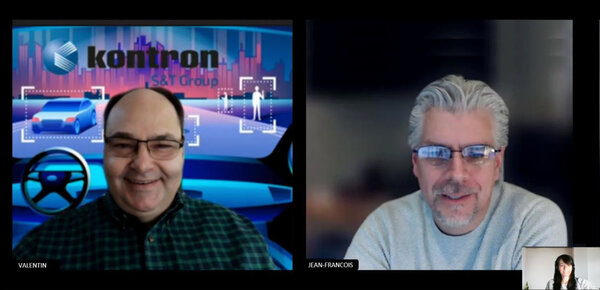
As we approach the end of what has been a life-changing year, I wanted to have a virtual chat with two of my very knowledgeable colleagues in Transportation – Valentin Scinteie, Director of Business Development and Jean-Francois Cleroux, Product Manager. I was curious to know their thoughts on how transportation has changed over the course of 2020, and what they believe is in store for this exciting industry in the next few years.
Tania: What are the biggest challenges we’re seeing in transportation right now?
Valentin: A huge challenge I see is that autonomous machines have yet to go mainstream. We aren’t seeing enough automation on the roads or construction sites despite many significant technological developments. Autonomous vehicles have changed the world of transportation dramatically by improving efficiency, productivity and of course, safety. A key benefit is the reduction in human error accidents, and although trust still remains a factor among the general population in regards to automated robots performing tasks for us, the reality is they are safer than a human. Through artificial intelligence (AI) and deep-learning technology, machines are improving the speed and accuracy of operations that enable customers to benefit from accelerated time-to-market, reduced total cost of ownership, as well as safety and performance.
By building a proof of concept (PoC), a customer is able, with the support of our Kontron team to build a solution and test it to ensure the results work for them. The market is on its way to becoming more mature, all thanks to companies like Tesla, Caterpillar and the investment of other industry innovators. For the customers struggling with where to start, we recommend doing it one PoC at a time. With so many use cases out there, it may be overwhelming. Ultimately, customers' favorite project characteristics are the ones that provide a solid ROI.
Jean-Francois: To Valentin’s point, the only true way to advance in this industry is by experimentation and constant improvement. With many developments in terms of accelerators, software stacks and partners, the flexibility to be able to adapt these systems into a customer’s infrastructure has never been greater. Kontron understands the significance of building state-of-the-art building blocks with short lead times. Our embedded systems can be rapidly upgraded with additional features as required to help the industry get there faster. Our wide portfolio of in-vehicle solutions made with industrial-based components are designed to meet the diverse requirements of the Intelligent Transportation Systems (ITS) Industry, so the market can focus on their core business, reduce their TCO and leave the rest to us.
Tania: And how are we helping them get started?
Valentin: We realize every customer has a different need and end goal. We complete and manage a lot of PoCs with customers where we all learn from those shared experiences. Based on the lessons learned, we are able to draw conclusions that better identify the right mix of technology that benefit customers with the same challenges. To solve a problem, you need multiple elements to come together and we work with a long list of strategic partners –software vendors, hardware vendors, and system integrators that help customers achieve their goals.
Tania: How has COVID-19 affected transportation?
Valentin: There have been disadvantages, and surprising advantages. We have seen growth in certain areas, despite this unprecedented crisis. Specifically, in transportation customers that decided to make their fleets more productive. They have taken the time to update their fleets during this slower-moving period to prepare themselves for the next few years of innovation and growth.
From a public transit and rail perspective, the pandemic has caused ridership to decline significantly resulting in a huge decrease in public funding. The government provides public funding to its cities in order to improve and expand public transit systems however, COVID has made it a lot more difficult to get. This area of transportation will have to reassess its strategies for a brighter future, but what I do know for sure is that autonomous vehicles will play a big role in stirring up change.
Avid readers of the daily news have likely taken notice of the rise in consolidations, mergers and acquisitions this year. Organizations going through financial difficulties have become attractive to larger enterprises with the cash flow to acquire them. Amazon acquired self-driving car start-up Zoox for an undisclosed amount, but reports suggest the transaction cost over $1 billion. Self-driving technology start-up Aurora acquired Uber’s automated driving unit, Uber ATG. These are just some of the major investments in self-driving technology that occurred over the course of the year.
Jean-Francois: The pandemic has accelerated the adoption of automation technology into overdrive. An effect of this acceleration is a resilience to future disruption that can provide an answer to a lack of manpower. We have not seen changes like this is in so many years, that it almost feels like it happened overnight. A good example is the growth of delivery robots – machines that deliver goods to homes such as food, medicine, cleaning products and household items. The demand for food delivery services like Doordash and UberEats due to lockdowns has skyrocketed, sometimes doubling revenue for these companies. Local agriculture has also been impacted in many ways. Farmers are using the technology to reach an efficiency level that wasn’t possible to achieve with traditional methods. They’re yielding more productivity from the same piece of land which means less waste, and more conservation of energy and fuel. And they’re considering the environment as they do it. A greener society and faster service are both key drivers for automated delivery.
COVID has certainly impacted the traffic and congestion we see on our roads. The notion of rush hour has virtually been blurred, and the volume of cars during the course of the day across every geography has lessened. Less congestion means fleets are able to maneuver goods and services to local citizens with fewer traffic interruptions or obstacles.
Tania: Any new transportation developments at Kontron for 2020?
Valentin: We are continuing to deploy autonomous technologies for our customers, and building intelligent in-vehicle systems for the modern driver and passenger. We did launch a new platform to enhance heavy-duty equipment in construction, agriculture, trucking and mining called the EvoTRAC S1901. The new platform fills an industry void by providing modular AI-optimized systems, designed to fuel GPU-accelerated applications from a compact, ruggedized form factor. Original equipment manufacturer (OEM) suppliers of industrial equipment have a strong requirement for versatile, intelligent solutions that can be easily adjusted based on highly customized demand, yet can also survive in the most extreme of environments.
Jean-Francois: I must highlight that the functional safety feature of this system is key. Any on or off-road vehicle using autonomous or semi-autonomous technologies will need embedded safety features to promote automatic protective responses in the event of a potential accident or input failure in a predictable manner. We plan to expand the product line to include more systems for industries where safety may be a concern.
Replacing the human in a value chain requires planning, methodology and safety. Integrating intelligent machines to do part of the work allows humans to focus on the bigger picture.
Tania: How do you see transportation evolving in the next few years?
Valentin: Major disruption is coming in as early as 5 to 10 years from now. While we all look forward to riding in the first flying car, key technologies like batteries, electrical vehicles, autonomous vehicles and on-demand transport are converging. As we work towards smarter cities, transportation will move into a mobile-as-a-service (MaaS) or transportation-as-a-service (TaaS) model where tailor-made mobility services will be offered to passengers based on an individuals needs. Less people are owning their own vehicles, thus using car ride and sharing services to get them from point A to point B are increasingly popular. In addition, people will be buying transportation packages on a monthly basis.
People will move away from owning cars as it will be more affordable to purchase packages and services like these. This shift will also have a positive impact on the environment. End-to-end trips for passengers will become more accessible and systems will have ample AI capabilities to better adapt to and plan journeys. Autonomous technologies will become more mature, legal frameworks will be better addressed and cost of tech will go down.
Jean-Francois: This industry is somewhat going through a perpetual learning phase right now. Algorithms for deploying in-vehicle systems are constantly evolving and requiring less expensive hardware. Kontron is actively solving this puzzle by investing more into learning the deployment models of today. We’re preparing for and also figuring out the right technology mix for fully commercial deployments of tomorrow, and keen to share our knowledge with our customers.
We’d love to hear more about your current needs, challenges and how COVID has impacted your business. If you would like to discuss any future transportation projects, feel free to contact us directly at [email protected]


{{comment.comment}}